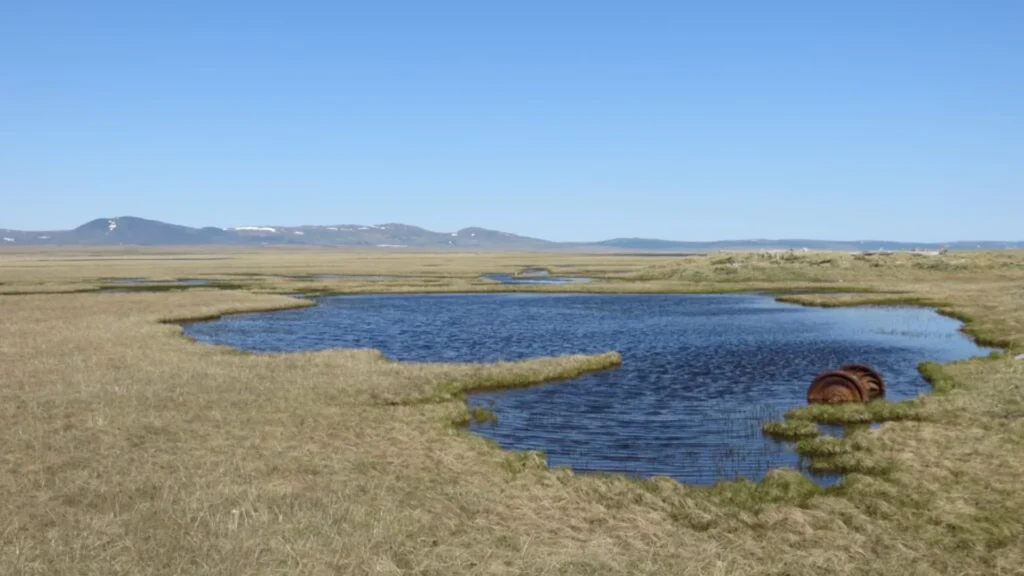As President Barack Obama plans to shift his focus to western Alaska by midweek, residents of Kotezbue—the northwest Arctic hub of fewer than 4,000 people—are making final preparations for the president’s historic visit above the Arctic Circle.
On Monday, all of Kotzebue was put the finishing touches on cleanup efforts and last-minute planning for the president’s visit. More than ten derelict houses had been knocked down as part of a community-wide cleanup that saw rusty cars, broken-down snowmachines, and more hauled away. But on Monday afternoon, Nelson Griest Junior was untangling his salmon net.
“From the last storm, it was pretty high … the water came up and washed my net out, and that’s where I’m at,” he said.
Nelson had a good summer netting chum salmon in Kotzebue’s small commercial fishery. He was working out of Kotzebue’s North Tent City, a city-built campground along a sliver of beach that offers fish racks and campsites for rent from May through September. It’s how Nelson says he’s spent his springs and summers since he can remember.
“It’s where I was born,” he said. “Lived down here over 15 years. My parents used to come here ever since the 70s. Every summer, they pretty much came down here. Springtime, they’d go out hunting ugurk and seal.”
This summer, his camp in the tent city fell into the water. It wasn’t the first time.
“It’s eroding,” he said. “It got my fish rack down here, dropped it down, fell one time. We put it back up. It’s really eroding down the coast, and every time the sand or rocks go down, there’s always ice in the bottom, on the tundra. So there is lots that’s melting, and I’m happy the president is coming. I’m excited.”
Nelson isn’t the only one talking about climate change in the lead up to Obama’s visit.
“It’s such an honor for him to come to our village, to see first-hand our concerns as a native community here,” said Nicole Stoops, the executive director of the Kotzebue IRA (the seats of tribal governments in many Alaska Native communities under the Indian Reorganization Act of 1936).
Stoops said the concerns go beyond impacts to seal hunting and salmon fishing. It’s anxiety about possible relocation for communities connected to the land through generations.
“It’s not such a simple thing to move a community as there are a lot of cultural ties to where they are now,” she said. “Just to understand the cultural ties the people have to the land, as well as finding something that would be logical and reasonable for the community members to feel comfortable on a move to relocate somewhere.”
Some of Kotzebue’s erosion issues, mainly along Shore Avenue, also known as Front Street, have been dealt with, at least for now. City manager Derek Martin said, after 50 years of half-measures, it was a tremendous effort to finally get it right.
“The permanent fix to this erosion problem along Shore Avenue [was] to install a series of sheet-pile bulkheads along 75 percent of [the road],” he said. “That provided the necessary infrastructure to prevent further erosion and to protect the roadway. But this was a fix that worked for this community as part of our erosion problem, as part of our climate change problem here in Kotzebue.”
It’s a solution Martin said he hopes to showcase during the president’s visit, one that demonstrates the resilience of rural communities.
It’s the kind of resilience Kotzebue Mayor Maija Lukin says is part of a life in rural Alaska. One she had to call on herself when her appendix burst this weekend.
What started off with nausea on Saturday turned into an emergency medevac to Anchorage and the quick removal of a dangerously inflamed appendix. Mayor Lukin was out of the hospital by Sunday, but she was only able to book a flight back home Monday night, just days before the president’s arrival.
It’s just one of the challenges about living in rural Alaska she puts up with to continue her family’s traditions.
“I know the time that he’s here is very short, and we’re showing him the best of everything we have. But it’s a very hard life that people don’t quite understand,” she said. “We choose to live in Kotzebue because it’s a beautiful place — it’s above the Arctic Circle. It’s a place where you can raise your children to hunt, fish, live off the land, and do what we were taught from our parents and grandparents.”
But while many prepare to press the president on climate change, others in Kotzebue just as quickly bring up the elephant in the room; or, in this case, the oil rig in the sea. Shell Oil is pursuing exploratory drilling in the Chukchi Sea this summer and staging ships, tugs, crews, and more in Kotzebue.
Some residents say they’re opposed to the drilling outright. Others say they’re more open to the idea. But on the eve of Obama’s visit focused on climate change, many in Kotzebue are quick to point out the incongruity: the president they are eager to welcome to their community, to talk candidly with about their needs when it comes to climate change, is the same president who authorized Shell’s Arctic drilling.
For Nelson, still tending his fishnets, it’s a straightforward decision.
“It’s not a good place to drill, I guess,” he said. “Because in fall time, when the ice is coming and the waves are getting bigger — I’m not sure about the cleanup. I think it’s going to be pretty hard in the Arctic.”
Oil and erosion, subsistence and climate change solutions; all topics on the minds of Kotzebue residents on the eve of the president’s visit to the Alaska Arctic.







